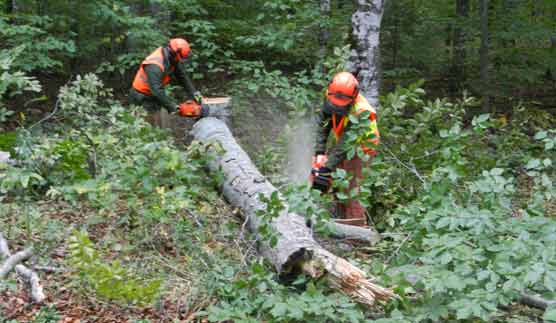|
You are viewing ARCHIVED content published online before January 20, 2025.
Please note that this content is NOT UPDATED, and links may not work. For current information,
visit https://www.nps.gov/aboutus/news/index.htm.

NPS photo by Chris Case
Contact: Bruce Leutscher, 906-387-2680 By Bruce Leutscher, Chief of Science and Natural Resources MUNISING, Michigan - Over the past several years, Beech Bark Disease has spread through Pictured Rocks National Lakeshore, killing hundreds and eventually thousands of beech trees. "This has been a very disheartening process to monitor," said Bruce Leutscher, Chief of Science and Natural Resources for Pictured Rocks."Our responsibility to the American people is to try to manage parks in such as way that they will remain unimpaired for the enjoyment of future generations.When something like this spreads through the park from outside, it is virtually impossible to meet that mandate." Accounts from Europe indicate that the disease was killing beech (Fagus sylvatica) before 1849. A scale insect, readily visible on the trees, was considered the cause of death until 1914, when it was learned, that a fungus, then identified as Nectria ditissima Tul., infected trees infested by the scale. Around 1890, the scale was accidentally brought to Nova Scotia. By 1932, the scale and an associated nectria fungus were killing trees throughout the mature beech areas of the Maritime Provinces and in Maine.The scale insect continued to spread to the north into Quebec and to the west and south throughout New England, New York, New Jersey, and Pennsylvania. In 2000, beech bark disease was first discovered in Michigan at Ludington State Park. The pattern of insect spread and the subsequent occurrence of nectria infection and tree death have led to an arbitrary classification of disease development over time and space: 1.The advancing front - areas recently invaded by the beech scale characterized by forests with many large, old trees supporting scattered, sparse, building populations of beech scale. 2.The killing front - areas characterized by high populations of beech scale, severe nectria attacks, and heavy tree mortality. 3. The aftermath zone - areas where heavy mortality occurred and now characterized by some residual big trees and many stands of small trees, often of root-sprout origin. Young stems are often defective through the interactions of beech scale, nectria fungus, and another scale insect, Xylococculus betulae. In forest stands, the disease cannot be controlled at a reasonable cost, and a program of timely salvage cuttings is the only way presently known to reduce disease losses. National Park Service management options do not include large scale, whole tree harvesting operations across extensive areas of park lands. The management option available is to address the aftermath forest and retain American beech to the extent possible and practical. Beech Bark Disease symptoms were first identified at Pictured Rocks in 2001. Since that time the park has been monitoring progression of the advancing front of the disease while planning and effecting removal of hazard trees from areas where hard targets exist (facilities, picnic areas, parking lots, etc.) while the killing front moves through. The killing front is now quickly spreading from east to west through Pictured Rocks resulting in a high mortality rate for beech trees. With no intervention this exotic disease complex may functionally remove an important native tree species which is an integral part of the northern hardwood forest type at Pictured Rocks. "The spread of beech bark disease has created a tremendous new workload for our staff," said Chief of Facility Management Chris Case."We have removed dozens of hazard tress from the park's developed areas and trails, and we expect this workload to continue for years to come." These trees are brittle and dangerous when dead, so we have had to be proactive about removing trees that we know are going to die, before they become too dangerous to remove." Following National Park Service policy, trees in more remote locations will be allowed to fall and return to the biomass, where they will help replenish soils and help support the next generation of trees that follow. This disease complex is similar in ways to Dutch Elm Disease and Chestnut Blight. But in those cases, the tree species were effectively eliminated from their native ranges. In the case of Beech Bark Disease, the tree species will still survive but the aftermath forests are expected to be perpetually young thickets of beech that do not play the same ecological role as maturing and mature forests. There is evidence that immediate action can identify methodology to utilize individual beech trees which exhibit resistance to this disease for restoration efforts. If mature beech trees are allowed to effectively disappear from Pictured Rocks' forests it will result in long-term ecological impacts that may be worsened by simultaneous effects of impending climate change. "This is a prime example of how human actions and introducing non-native species can permanently alter the ecology of an area," Leutscher concluded. About the National Park Service. More than 20,000 National Park Service employees care for America's 397 national parks and work with communities across the nation to help preserve local history and create close-to-home recreational opportunities. Learn more at www.nps.gov. |
Last updated: April 10, 2015
